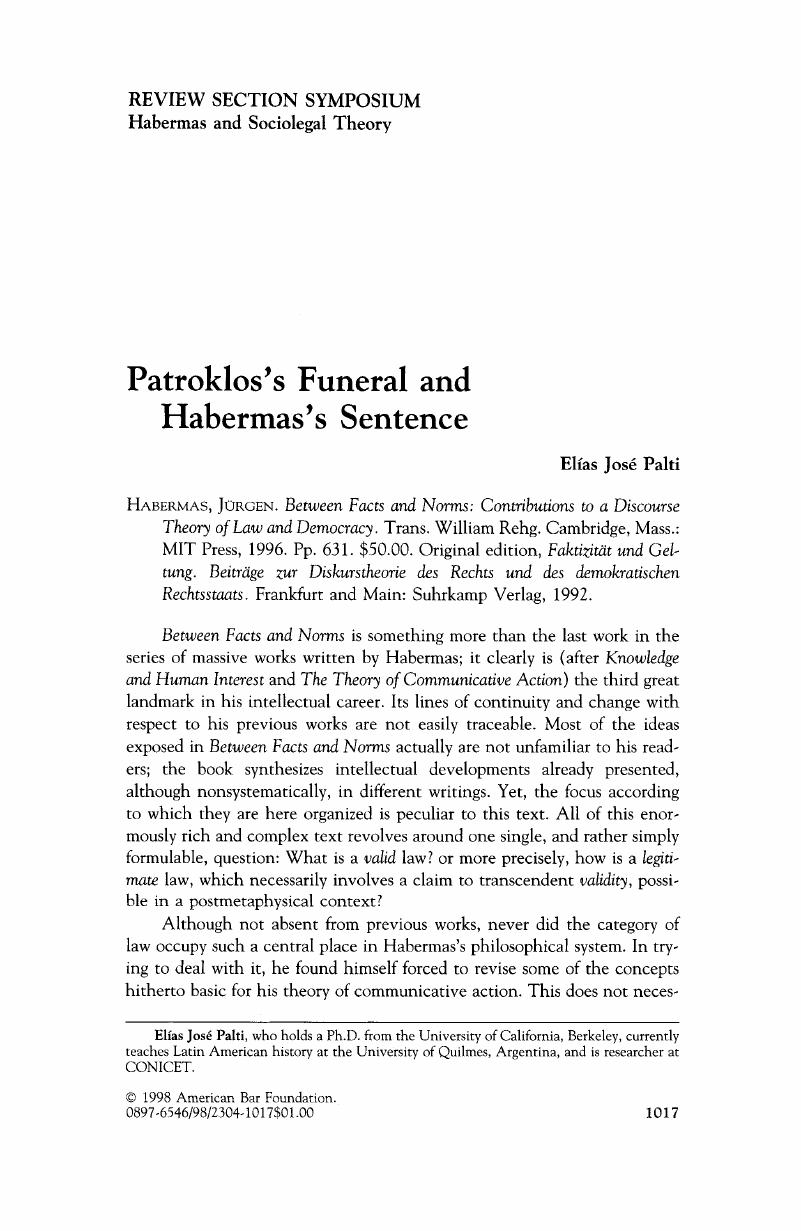No CrossRef data available.
Article contents
Patroklos's Funeral and Habermas's Sentence
Published online by Cambridge University Press: 27 December 2018
Abstract
An abstract is not available for this content so a preview has been provided. Please use the Get access link above for information on how to access this content.

- Type
- Review Section Symposium
- Information
- Copyright
- Copyright © American Bar Foundation, 1998
References
Apel, Karl-Otto. 1992. Normatively Grounding “Critical Theory” through Recourse to the Lifeworld? A Transcendental-Pragmatic Attempt to Think with Habermas against Habermas. In Political Interventions in the Unfinished Project of Enlightenment, ed. Honneth, Axel, McCarthy, Thomas, Offe, Claus, and Wellner, Albrecht. Cambridge, Mass.: MIT Press.Google Scholar
Baker, Keith. 1992. Defining the Public Sphere in Eighteenth-Century France: Variations on a Theme by Habermas. In Calhoun 1992.Google Scholar
Balibar, Etienne. 1991. Citizen/Subject. In Who Comes After the Subject? ed. Cadava, E., Connor, P., and Nancy, J. L.
New York and London: Routledge.Google Scholar
Benhabib, Seyla. 1992a. Models of Public Space: Hannah Arendt, the Liberal Tradition, and Jürgen Habermas. In Calhoun 1992.Google Scholar
Benhabib, Seyla. 1992b. Autonomy, Modernity, and Community: Communitarianism and Critical Social Theory in Dialogue. In Political Interventions in the Unfinished. Project of Enlightenment, ed. Honneth, Axel
et al. Cambridge, Mass.: MIT Press.Google Scholar
Bubner, Rudiger. 1992. Antike Themen und ihre moderne Verwandlung. Frankfurt and Main: Suhrkamp.Google Scholar
Calhoun, Craig, ed. 1992. Habermas and the Public Sphere. Cambridge, Mass.: MIT Press.Google Scholar
Döber, Rainer. 1990. Against the Neglect of Content in the Moral Theories of Kohlberg, and Habermas. In The Moral Domain: Essays on the Ongoing Discussion between Philosophy and the Social Sciencies, ed. Wren, T. E.
Cambridge, Mass.: MIT Press.Google Scholar
Dwars, Ingrid. 1992. Application Discourse and the Special Case-Thesis. Ratio Juris
5:67–78.Google Scholar
Fraser, Nancy. 1992. Rethinking the Public Sphere: A Contribution to the Critique of Actually Existing Democracy. In Calhoun 1992.Google Scholar
Günther, Klaus. 1990. Impartial Application of Moral and Legal Norms: A Contribution to Discourse Ethics. In Universalism vs. Communitarianism: Contemporary Debates in Ethics, ed. Rasmussen, D.
Cambridge, Mass.: MIT Press.Google Scholar
Habermas, Jürgen. 1984. The Theory of Communicative Action. Vol. 1. Boston: Beacon Press.Google Scholar
Habermas, Jürgen. 1991a. The Structural Transformation of the Public Sphere: An Inquiry into a Category of Bourgeois Society. 1962. Reprint, Cambridge, Mass.: MIT Press.Google Scholar
Habermas, Jürgen. 1991b. Questions and Counterquestions. In Habermas and Modernity, ed. Bernstein, R.
Cambridge, Mass.: MIT Press.Google Scholar
Habermas, Jürgen. 1993. Justification and Application: Remarks on Discourse Ethics. Cambridge, Mass.: MIT Press.Google Scholar
Huntington, Samuel. 1993. The Clash of Civilizations
Foreign Affairs Quarterly
72(Summer):22–49.Google Scholar
Jacobi, F. H.
1812. Beylage to David Hume über den Glauben, oder Idealismus und Realismus, ein Gespräch
. In Werke, ed. Jacobi, F. H. and Köppen, F. Vol. 2. Leipzig: Fleischer.Google Scholar
Kantorowicz, Ernst H.
1981. The King's Two Bodies: A Study in Mediaeval Political Theology. 6th ed. Princeton, N.J.: Princeton University Press.Google Scholar
Kelly, Michael. 1990. Maclntyre, Habermas, and the Philosophy of Ethics. In Hermeneutics and Critical Theory in Ethics and Politics, ed. Kelly, Michael. Cambridge, Mass.: MIT Press.Google Scholar
Kohlberg, Lawrence. 1987. The Philosophy of Moral Development. New York: Harper & Row.Google Scholar
MacDowell, Douglas. 1978. The Law in Classical Athens Aspects of Greek and Roman Life. Ithaca, N.Y.: Cornell University Press.Google Scholar
McCarthy, Thomas. Practical Discourse: On the Relations of Morality to Politics. In Calhoun
1992.Google Scholar
Pensky, Max. 1995. Universalism and the Situated Critic. In The Cambridge Companion to Habermas, ed. White, Stephen. Cambridge, England: Cambridge University Press.Google Scholar
Peters, Bernhard. 1994. On Reconstructive Legal and Political Theory. Philosophy and Social Criticism
20:71–100.Google Scholar


